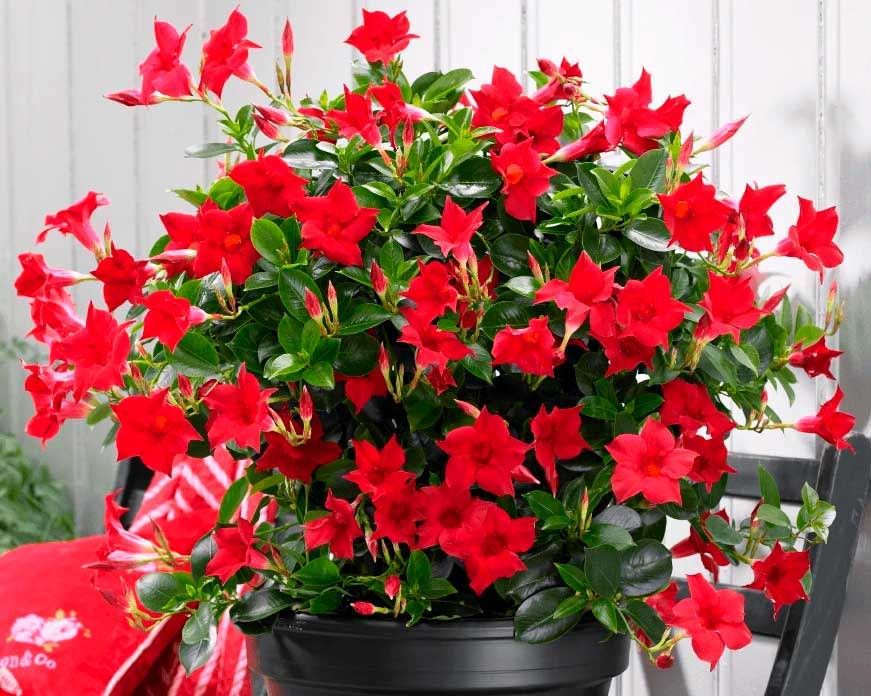With their elegant, trumpet-shaped blooms in shades of pink, red, and white, mandevilla vines add tropical flair to gardens, patios, and containers. Getting your mandevilla to bloom generously requires providing ideal growing conditions. While mandevillas are not the most demanding plants, they do have preferences when it comes to sunlight, water, temperature, and care. Follow these tips to coax the most prolific flowering from your mandevilla vine.
Sunlight for Optimal Mandevilla Blooms
Bright light is key for prolific mandevilla blooms. These vines thrive in full sun – aim for at least 6 hours of direct sun daily. Morning sun is ideal. While mandevillas can take partial sun, flower production will be reduced. Insufficient sunlight results in sparse, lackluster blooms. Site your mandevilla where it will soak up the sun’s rays.
If keeping your vine indoors, situate near a bright south- or west-facing window. Turn the plant periodically so all sides get evenly illuminated. Supplement with grow lights if sunlight is limited. Proper exposure promotes robust flowering.
Ideal Watering for Mandevilla Flowers
Flowers need the right balance of water. Too little or too much water causes problems. Mandevillas like consistently moist, but not soggy soil Water thoroughly until it drains from the pot Allow the top inch of soil to dry before watering again. Proper drainage is critical to prevent root rot.
Reduce watering frequency in fall and winter when growth slows. Drought stress can cause buds and blooms to drop. But overwatering is equally detrimental. Ensure pots and plants have drainage holes and never let mandevilla sit in water.
Temperature Conditions for Blooms
Mandevilla thrives in daytime temperatures of 70-85°F and above 60°F at night. Cooler conditions below 60°F often prevent flowering. Moving mandevilla indoors or using row covers can help when nights turn chilly. Avoid exposing mandevilla to temperatures below 50°F which damage the plant. Heat-loving mandevillas luxuriate in summer’s warmth, rewarding you with abundant blooms.
Proper Care and Fertilizing
Well-cared for mandevillas pump out the flowers Apply balanced fertilizer every 2-3 weeks during spring and summer. Look for formulations labeled for blooming plants Slow release pellets or liquids work. Avoid over-fertilizing which stresses plants. Trim back wayward vines to encourage bushy, flowering growth.
Repotting in fresh soil annually invigorates mandevilla. Prune old plants back by half their size in late winter to promote new growth and flowers. Locate containers in protected areas away from harsh winds. Rotate indoor plants for even growth. Proper care keeps mandevillas flowering freely.
Troubleshooting Lack of Mandevilla Blooms
If your mandevilla vine refuses to bloom look for these common issues
- Too little sunlight – Move to a sunnier spot.
- Overwatering or underwatering – Adjust to keep evenly moist.
- Low temperatures – Protect from cold nights below 60°F.
- High nitrogen fertilizer – Switch to a balanced formula.
- Over pruning – Avoid radical cutting back.
- Rootbound plant – Repot in roomy container with fresh soil.
Correct any problems to get your mandevilla blooming abundantly again.
Companion Plants to Complement Mandevilla
Here are some excellent options for planting with mandevilla:
- Flowering tobacco (Nicotiana) – Fragrant white flowers
- Angel wing begonia – Bright leaves and pink blooms
- Lantana – Vibrant clusters of multicolored flowers
- Dwarf trailing lantana – Low-growing with purple-pink blooms
- Sweet potato vine – Decorative chartreuse or purple foliage
- Vinca or Madagascar periwinkle – Rosy flowers and foliage
Combine mandevilla with these beauties for stunning container combos and mixed flower borders.
Relish the Remarkable Blooms of Mandevilla
With proper sunlight, water, fertilizer and care, mandevilla vines burst into generous flowering. Train them up supports and enjoy the dangling pink, red or white blossoms all season long. Mandevilla adds such impressive floral displays that it’s worth taking the time to encourage these beauties to bloom their best. Sit back and admire the elegant flowers as hummingbirds and butterflies flock to partake of their nectar. Let mandevilla infuse your garden with a taste of the tropics!
Your Green Thumb Support
Mon-Thur, 7 AM – 8 PM CST
Fri, 7 AM – 5 PM CST
Sat-Sun, 8 AM – 5 PM CST
Mon-Fri, 8 AM to 5 PM CST
Mandevillas bold and abundant flowers make this vine well loved by many gardeners. During the summer and fall, this plant, which is also called rock trumpet, has flowers all over its long vines. It can be very disappointing if your Mandevilla is not flowering or the buds are not opening. It’s always because of something that the plant doesn’t bloom. If you can figure it out, you can fix it. Here are some common reasons why Mandevilla isn’t blooming.
Pruning Mandevilla To Help It Bloom
Mandevilla develops a naturally attractive form, but the plant can be trimmed if it is overgrown. Leggy plants may not be able to push out as many blooms. Trimming the plant back will encourage more growth, leading to more flowers.
How to GROW Mandevilla Plants & Get MAXIMUM Flowers
FAQ
Why is my mandevilla not flowering?
What is the best fertilizer for mandevilla?
How long does it take for mandevilla to bloom?
- The Ultimate Guide to Growing Strawberries in Raised Beds - August 8, 2025
- No-Dig Garden Beds: The Easiest Way to Grow a Beautiful Garden - August 6, 2025
- How to Protect and Preserve Wood for Raised Garden Beds - August 6, 2025

